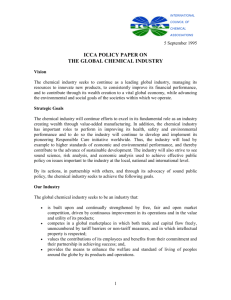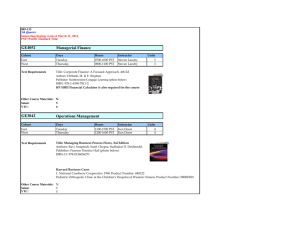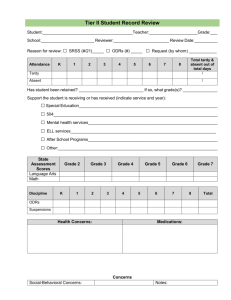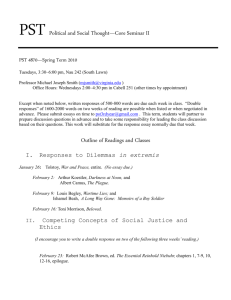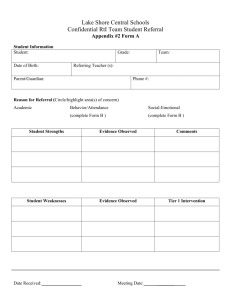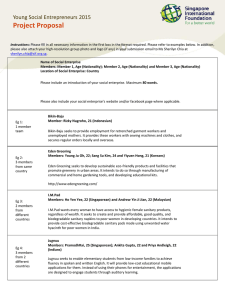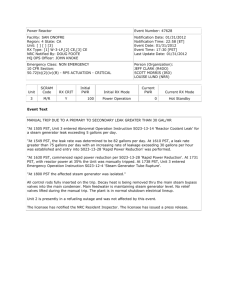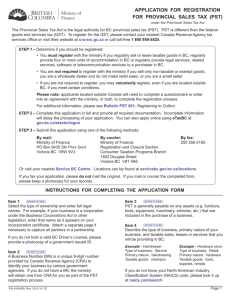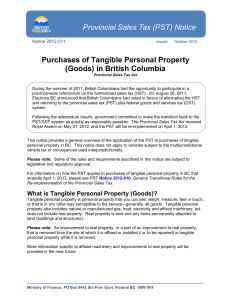Problem Solving Team Intervention Planning Tool
advertisement
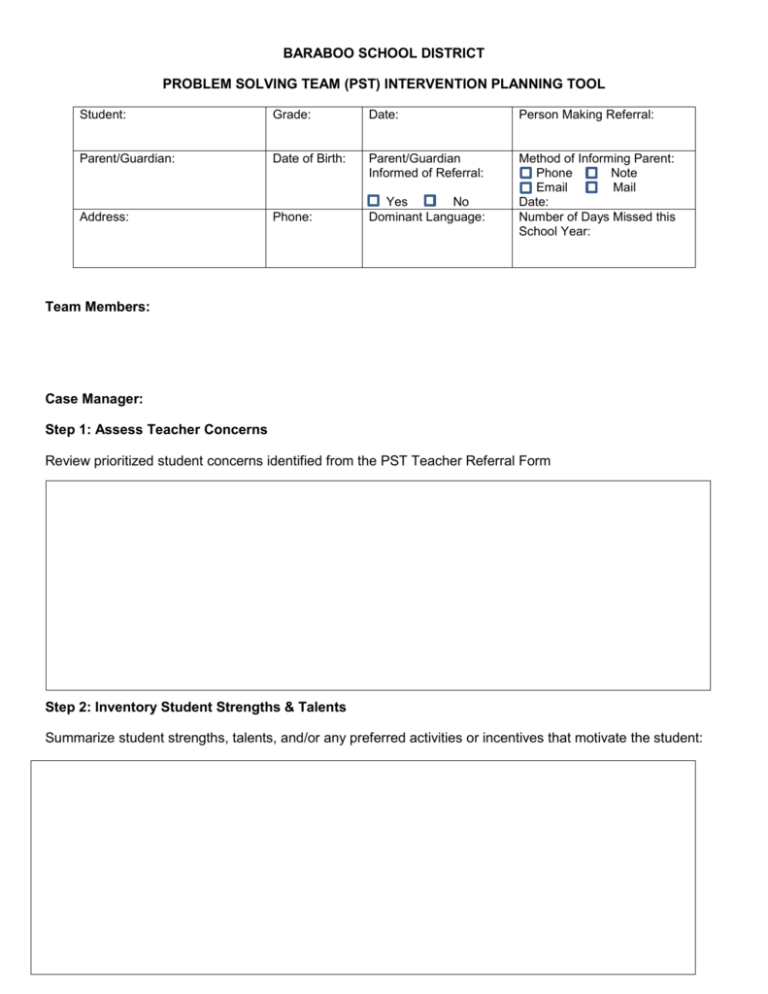
BARABOO SCHOOL DISTRICT PROBLEM SOLVING TEAM (PST) INTERVENTION PLANNING TOOL Student: Grade: Date: Person Making Referral: Parent/Guardian: Date of Birth: Parent/Guardian Informed of Referral: Address: Phone: Method of Informing Parent: Phone Note Email Mail Date: Number of Days Missed this School Year: Yes No Dominant Language: Team Members: Case Manager: Step 1: Assess Teacher Concerns Review prioritized student concerns identified from the PST Teacher Referral Form Step 2: Inventory Student Strengths & Talents Summarize student strengths, talents, and/or any preferred activities or incentives that motivate the student: Step 3: Review Background/Baseline Data Summarize any relevant background or baseline data collected on the student Step 4: Select Target Teacher Concerns Define the top 1-2 concerns in observable terms (top 1-2 difficulties that most interfere with the student’s functioning in the classroom). Targeted concerns must be clearly connected to multiple types of data, be related to variables that are under the control of school, and be alterable. 1. Reasons/Functions for Behavior Behavioral Academic Lacks necessary skills Lacks necessary skills Has limited motivation Has limited motivation Seeks att’n from adults Struggling academically in Reacting to teasing/bullying current instructional placement Tries to escape from work Needs drill & practice demands or setting Other: Seeks access to privileges, rewards Seeks sensory stimulation (e.g., playing with objects) Other: 2. Reasons/Functions for Behavior Behavioral Academic Lacks necessary skills Lacks necessary skills Has limited motivation Has limited motivation Seeks att’n from adults Struggling academically in Reacting to teasing/bullying current instructional placement Tries to escape from work Needs drill & practice demands or setting Other: Seeks access to privileges, rewards Seeks sensory stimulation (e.g., playing with objects) Other: Are the targeted concerns a performance deficit or a skill deficit? Step 5: Set Academic and/or Behavioral Outcome Goals and Methods for Progress-Monitoring Fill out the details for each intervention goal (to a maximum of two) in the table below. At the bottom of the table, you will combine the elements of the goal into a single student ‘goal statement’. NOTE: For help in completing this section, refer to the PST Companion Guide. Intervention Goal 1 Describe in measurable, observable terms the behavior that is to be changed (taken from Step 4): Intervention Goal 2 Describe in measurable, observable terms the behavior that is to be changed (taken from Step 4): What is the target date to achieve this goal? _______ / ______ /________ What is the target date to achieve this goal? _______ / ______ /________ Is the goal for the behavior to be: ___ increased? or ___ decreased? Is the goal for the behavior to be: ___ increased? or ___ decreased? What are the conditions under which the behavior typically appears (problem behaviors) or should be displayed (desired behaviors)? What are the conditions under which the behavior typically appears (problem behaviors) or should be displayed (desired behaviors)? What is the goal (level of proficiency) that the student is expected to achieve by the date listed above? What is the goal (level of proficiency) that the student is expected to achieve by the date listed above? What measure(s) will be used to monitor student progress? a. What measure(s) will be used to monitor student progress? a. b. b. How frequently will this student goal be monitored? (e.g., weekly?, daily?) How frequently will this student goal be monitored? (e.g., weekly?, daily?) How will we know if the student is responding to the intervention (i.e. what rate of growth would we like to see)? How will we know if the student is responding to the intervention? Who is responsible for monitoring this student goal? Who is responsible for monitoring this student goal? Write a goal statement based on your responses: Write a goal statement based on your responses: By the target date of _________________________, By the target date of _________________________, [Target date] when _____________________________________, [Conditions in which the behavior is likely to appear] [Step 2: Target date] when ____________________________________, [Step 4: Conditions in which the behavior is likely to appear] the student will increase / decrease the behavior the student will increase / decrease the behavior ____________________________________________ [Definition of behavior] __________________________________________ [Step 1: Definition of behavior] to achieve the goal of _________________________ [ Proficiency goal] to achieve the goal of ________________________ [Step 5: Proficiency goal] as evidenced by _____________________________. [targeted rate of growth] as evidenced by ____________________________. [targeted rate of growth] Step 6: Design an Intervention Plan Date the intervention will begin: _________________________ Intervention Check This step took place Y__ N__ This step took place Y__ N__ This step took place Y__ N__ Intervention Preparation Steps: Describe any preparation (creation or purchase of materials, staff training, etc.) required for this intervention. Person(s) Responsible Intervention Check Intervention Steps: Describe the steps of the intervention, including how progress will be monitored. Include enough detail so that the procedures are clear to all who must implement them. Person(s) Responsible This step took place Y__ N__ This step took place Y__ N__ This step took place Y__ N__ This step took place Y__ N__ This step took place Y__ N__ This step took place Y__ N__ Research Citation(s) / References: If possible, list the published source(s) that make this a ‘scientifically based’ intervention. Step 7: Plan to Contact Parents Who will share details from this meeting with the student’s parent(s) and when? Step 8: Follow-Up At the close of the meeting: -up PST meeting on this student. Next meeting date & time: ________________________________ (NOTE: Generally, follow-up meetings are scheduled 6-8 instructional weeks from the start date of the intervention. -upon time within the next school week to meet with the referring teacher(s): Date and time for case manager to meet with the referring teacher(s): ________________
